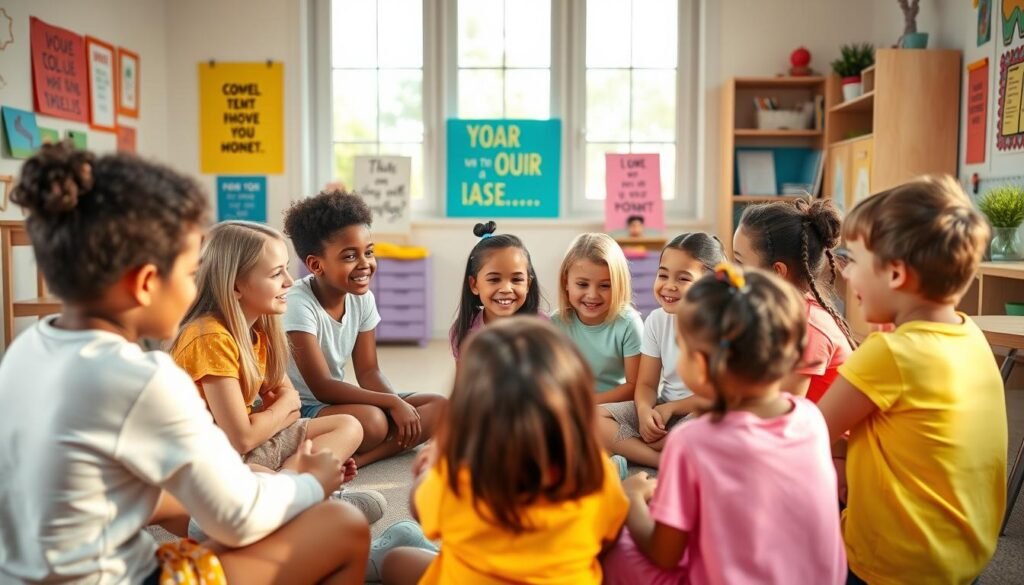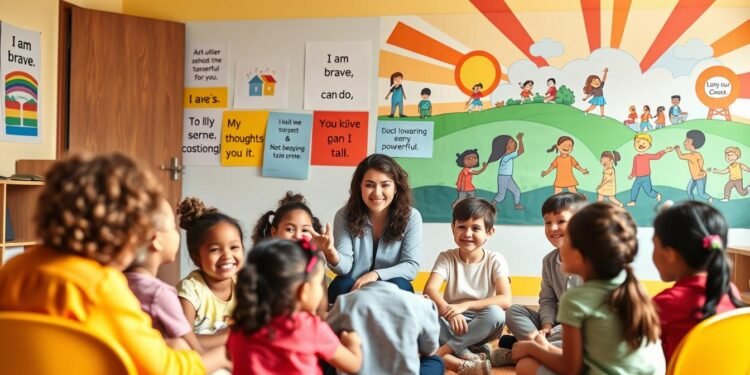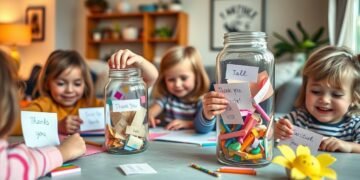Have you ever wondered how the words children say to themselves shape their future? Internal dialogue, often called self-talk, plays a crucial role in how young minds perceive challenges and opportunities. This inner voice can either build confidence or create doubt, making it essential to guide children toward constructive narratives.
Replacing negative thoughts with empowering ones can transform how children approach life. Daily practice of these habits helps them develop resilience and a growth mindset. Simple activities like modeling, affirmation exercises, and using third-person language can make a significant difference.
Research shows that third-person self-talk improves emotional regulation and objectivity. By teaching children to reframe their thoughts, we equip them with tools for lifelong success. Let’s explore practical strategies to nurture this skill effectively.
Key Takeaways
- Internal dialogue shapes children’s perceptions and behaviors.
- Constructive narratives replace negative thoughts effectively.
- Daily practice builds lifelong positive thinking habits.
- Modeling and affirmation exercises are actionable strategies.
- Third-person self-talk enhances emotional regulation.
What is Positive Self-Talk?
Internal dialogue is a powerful tool that influences how we see the world. It’s the automatic mental narration that accompanies our daily experiences. Constructive internal dialogue, often called positive self-talk, helps build confidence and resilience. It’s about viewing oneself optimistically, even when facing challenges.
In contrast, negative self-talk, like “I can’t do this,” limits potential. This type of thinking reinforces a fixed mindset, where abilities feel unchangeable. For example, saying “I’m bad at math” shuts down growth, while “I can improve with practice” opens doors to learning.
The way we frame our thoughts impacts our actions. Repeated patterns of constructive or destructive thinking strengthen neural pathways. Over time, these pathways shape how we respond to challenges. Younger children often need explicit guidance to recognize and reframe their internal dialogue.
Thinking positively can rewire these pathways, fostering a growth mindset. Simple shifts, like replacing “I’ll never get this right” with “This is tough, but I’ll try,” make a big difference. Teaching these skills early sets the foundation for lifelong emotional resilience.
Why is Positive Self-Talk Important for Kids?
The way children think about themselves can shape their entire outlook on life. Their inner dialogue influences how they perceive challenges, handle emotions, and make decisions. By fostering constructive thinking, we can help them build resilience and confidence.

Influences Perception
Children who practice constructive thinking are more likely to see mistakes as opportunities to learn. This optimism bias helps them approach problems with a growth mindset. For example, instead of saying “I can’t do this,” they might think, “I’ll try again and get better.”
Affects Emotional Response
Constructive inner dialogue can lower stress levels during tough situations. Research shows that using a third-person perspective reduces anxiety. This helps children stay calm during tests or performances, making it easier to focus and succeed.
Shapes Behavior
When children replace negative thoughts with empowering ones, they become more persistent. Studies show that competence-focused statements increase persistence in challenging activities by 37%. This can lead to better performance in school and hobbies.
Impacts Decision-Making
Constructive thinking enhances risk assessment in social scenarios. For instance, children are better at resolving playground conflicts when they approach them with optimism. This skill helps them make thoughtful decisions in everyday life.
Over time, these habits prevent self-fulfilling prophecies of failure. By teaching children to reframe their thoughts, we equip them with tools for lifelong success. This has a lasting impact on their behavior and overall well-being.
Benefits of Positive Self-Talk for Kids
Building a habit of constructive inner dialogue can unlock a child’s full potential. This practice not only boosts their confidence but also helps them navigate life’s challenges with ease. Let’s explore the key advantages of fostering this skill.
Academically, children who use affirmations before tests score 22% higher on average. This shows how a supportive inner voice can enhance focus and performance. It’s a simple yet powerful tool for academic success.
Socially, calm self-instruction reduces playground conflicts by 40%. When children approach disagreements with a composed mindset, they’re better equipped to resolve issues peacefully. This skill fosters healthier relationships with peers.
Physiologically, constructive thinking decreases stress-related symptoms like stomachaches and headaches. Studies show that managing stress through inner dialogue improves overall physical health. It’s a natural way to promote well-being.
Emotionally, children recover faster from setbacks, such as losing a team sport. They learn to view challenges as opportunities for growth rather than failures. This resilience builds a foundation for lifelong success.
Long-term, this practice correlates with a 31% lower rate of teen depression. By teaching children to reframe their thoughts, we equip them with tools to handle life’s ups and downs. It’s an investment in their future mental health.
Encouraging a healthy inner dialogue helps kids manage anger and build emotional resilience. These benefits extend into adulthood, shaping confident and capable individuals. Start nurturing this skill today for lasting impact.
Examples of Positive Self-Talk
Practical scenarios show how small changes in thinking can lead to big results. These examples highlight how replacing limiting beliefs with empowering ones can transform a child’s approach to challenges.
In academic settings, instead of thinking, “I’ll never able to pass this test,” a child might say, “I prepared well—I’ll show what I know!” This shift reduces test anxiety and boosts confidence.
Socially, children often assume rejection. A better approach is, “They might be busy—I’ll ask again later.” This encourages persistence and reduces negative assumptions.
For skill-building, like sports or music, “Each practice gets me closer” replaces frustration with progress. This mindset fosters perseverance and growth.
Emotional regulation is another key area. Instead of feeling overwhelmed, a child might say, “Big feelings pass—I’ll breathe through this.” This helps them manage stress effectively.
Finally, adopting a growth mindset involves seeing mistakes as opportunities. “Mistakes are my brain’s building blocks” encourages learning from errors rather than fearing them.
These thoughts positive examples demonstrate how simple shifts in language can build resilience and confidence. By practicing these phrases, children develop a healthier inner dialogue that supports their growth.
How to Teach Positive Self-Talk to Kids
Guiding children to develop a supportive inner voice can shape their emotional and mental growth. By teaching them to replace limiting thoughts with empowering ones, we equip them with tools to navigate life’s challenges. Here are effective ways to foster this skill.
Model Positive Self-Talk
Children learn by observing adults. Demonstrate “think aloud” processing during challenges. For example, say, “This is hard, but I’ll try my best.” This helps them see how to handle difficulties constructively.
Identify Negative Self-Talk
Use tools like mood meters to link emotions with internal dialogue. Help them recognize phrases like “I can’t do this” and reframe them. This step is crucial to identify negative patterns.
Teach Positive Affirmations
Collaborate with children to create personalized mantras. Phrases like “I am capable” or “I learn from my mistakes” can boost confidence. Repeating these positive affirmations reinforces a growth mindset.
Practice Challenging Negative Thoughts
Use worksheets with real-life scenarios to teach cognitive restructuring. For instance, replace “I’ll never get this right” with “I’ll improve with practice.” This builds resilience.
Encourage Self-Compassion
Teach children to treat themselves kindly. Phrases like “It’s okay to make mistakes” foster self-acceptance. This helps them handle setbacks without harsh self-criticism.
Offer Positive Reinforcement
Use sticker charts to reward moments of constructive thinking. This motivates children to practice empowering language regularly.
Make It Fun
Turn learning into a game. Play “Positive Detective” to spot constructive language in media. This makes the process engaging and memorable.
Positive Self-Talk Activities for Kids
Engaging in creative exercises can help children build a supportive inner dialogue. These activities are designed to make learning fun while fostering a growth mindset. By incorporating these practices into daily routines, children can develop resilience and confidence.

Positive Thought Jars
One effective tool is the thought jar. Children decorate a container and fill it with daily optimism notes. These notes can include affirmations or reflections on their achievements. This activity encourages them to focus on the good in their lives.
Compliment Circles
Another engaging method is the compliment circle. In a group setting, children take turns sharing kind words about each other. This practice boosts self-esteem and teaches the value of encouragement. It’s a simple yet powerful way to promote positivity.
Growth Mindset Activities
Activities that emphasize a growth mindset are also beneficial. For example, creating vision boards with “I can” statements helps children visualize their goals. Journaling gratitude logs or integrating STEM projects with encouraging verbal commands can also reinforce constructive thinking.
These tools and activities provide practical ways to nurture a healthy inner dialogue. By making these practices a regular part of their lives, children can develop the skills needed to thrive in any situation.
Conclusion
The words we use internally can shape how we approach life’s challenges. Research shows that positive self-talk is a powerful tool for building resilience and confidence. By translating this science into daily practice, children can develop healthier thought patterns over time.
Consistency matters more than perfection. Small, regular efforts to reframe negative thoughts can lead to lasting change. If entrenched patterns persist, seeking professional help can provide additional support.
Encourage family-wide practice to reinforce these skills. When everyone participates, it creates a supportive environment for growth. At school or home, these habits can make a significant difference.
Remember, words shape worlds—especially the ones we tell ourselves. Start nurturing a constructive inner dialogue today for a brighter tomorrow.
FAQ
What is positive self-talk?
It’s the practice of using encouraging words to build confidence and resilience, helping children replace negative thoughts with uplifting ones.
Why is it important for children?
It influences how they perceive challenges, manage emotions, and make decisions, fostering a healthier mindset and better coping skills.
How does it shape behavior?
By replacing doubt with confidence, it encourages kids to take on challenges, persevere, and develop a growth mindset.
What are some examples of positive affirmations?
Phrases like “I can do hard things,” “I am kind and capable,” or “Mistakes help me learn” are great starters for building self-belief.
How can parents teach this skill?
By modeling it themselves, helping kids recognize negative thoughts, and practicing affirmations through fun activities like compliment circles.
What are some effective activities to practice?
Positive thought jars, growth mindset exercises, and role-playing scenarios can make learning engaging and impactful.
How does it impact emotional responses?
It helps children manage stress, anger, and anxiety by shifting their focus to solutions and their own strengths.
Can it improve decision-making?
Yes, by fostering a confident and thoughtful mindset, kids are better equipped to make choices that align with their goals.






